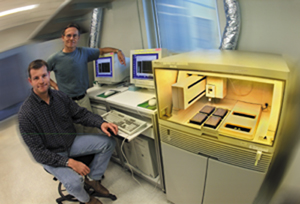|
Dr. Eddy Rubin, a geneticist who heads the Genome Sciences
Department in Berkeley Lab's Life Sciences Division, and Len
Pennacchio, a member of Rubin's research group, led the team
that found the new gene, which they named apoAV. They used
transgenic mice to identify and test the gene, then compared
their findings to clinical studies on humans to determine
its influence on triglyceride levels.
"By comparing the sequence of the genomes of humans and
mice we have found a genetic jewel that had been missed when
the sequence of the human genome alone was analyzed,"
says Rubin. "ApoAV appears to have a major role in lipid
metabolism in both humans and mice."
|
| "By comparing
the sequence of the genomes of humans and mice, we found
a genetic jewel that had been missed." |
|
Heart disease remains the leading cause of death in the United
States. The majority of these deaths are the result of atherosclerosis-the
hardening of arteries through the buildup of plaque deposited
primarily by plasma lipids such as low density lipoprotein
(LDL), also known as "bad cholesterol," and triglycerides.
Many Americans have sought to reduce atherosclerosis through
careful diet, but dietary effects can vary widely among individuals
depending upon their genetic and metabolic profiles.
It is well established that a cluster of apolipoprotein
genes along human chromosome 11-known as the apoAI/CIII/AIV
region-has a major influence on plasma lipid profiles and,
consequently, atherosclerosis susceptibility. It is also well
known that mutations in DNA sequences within this region can
contribute to severely elevated triglyceride levels. Since
the DNA for the apoAI/CIII/AIV region has now been fully sequenced
as a result of the Human Genome Project, Rubin, Pennacchio,
and the other members of the team searched for additional
genes in the region by looking for any sequences that had
been conserved through evolution in both humans and mice.
|
|
 |
 |
| |
|
| |
Eddy Rubin, head of Berkeley Lab's Genome
Sciences Department (right) and Len Pennacchio, a member
of Rubin's research group, led the team that found a new
gene--apoAV--which plays a significant role in controlling
blood triglyceride levels, an important risk factor in
heart disease development. |
|
|
"The approach we took was based on the concept that
if a segment of the genome has been conserved over the 60
million years since humans and mice are believed to have diverged,
then the sequence within the segment probably encodes an important
biological function," explains Rubin. "Accordingly,
in scanning the genomes of mice and humans we focused our
attention specifically on those sequences shared by humans
and mice."
ApoAV was introduced into a strain of mice through standard
transgenic technology and engineered to overexpress itself.
Other mice were engineered to lack apoAV. Comparing the two
groups revealed a dramatic contrast.
Says Pennacchio, "Mice expressing human apoAV showed
a 300 percent decrease in plasma triglyceride concentrations,
while the knockout mice lacking apoAV showed a 400 percent
increase."
Having identified apoAV and determined its influence on triglyceride
concentrations in mice, the researchers next examined the
relationship between DNA-sequence polymorphisms in the apoAV
gene and plasma lipid levels in humans.
"To serve as genetic markers for association studies,
we identified single nucleotide polymorphisms (SNPs) across
and surrounding the human apoAV gene," says Rubin. "Four
markers with relatively high minor allele frequencies were
obtained and scored in approximately 500 random unrelated
Caucasian individuals (mostly males) who had been phenotyped
for numerous lipid parameters before and after consumption
of high- and low-fat diets."
|
|
 |
|
| |
 |
| A human/mouse sequence comparison plot
reveals apoAV adjacent to the gene ZNF259. The sequence
conservation curve is colored to indicate where human/mouse
sequence alignments achieve greater than 50% similarity
(translated exons are red, untranslated exons green, noncoding
conserved sequences are blue). ApoAV was identified through
this cross-sequence analysis. The gene modulates triglyceride
levels in both humans and mice. |
|
| |
|
A second human association study using a different experimental
design was also performed, this time on some 400 individuals
drawn from the extreme ends of a clinical study encompassing
several thousand subjects. In both studies, a strong link
was found between plasma triglyceride levels and SNPs across
the apoAV gene.
Says Rubin, "The two human studies indicated that a common
sequence variation in the vicinity of apoAV is inherited in
more than 10 percent of the population and appears to result
in a 20- to 30-percent increase in an individual's blood triglyceride
levels."
Rubin and Pennacchio believe it may be possible to use apoAV
polymorphisms as prognostic indicators for hyper-triglyceridemia
susceptibility and that apoAV modulation could be a potential
strategy to reduce this cardiovascular disease risk factor.
The next step, they say, is to identify DNA sequence variations
that lead to lower apoAV protein concentrations in the blood.
Working with Rubin and Pennacchio on this study were Dr. Ronald
Krauss, a physician with Berkeley Lab's Life Sciences Division
recognized as a leading authority on genetic risk factors
in heart disease, plus Michael Olivier and David Cox at Stanford
University's Human Genome Center, Jaroslav Hubacek and Jonathan
Cohen of the University of Texas Southwestern Medical Center,
and Jean-Charles Fruchart of the University of Lille in France.
-- Lynn Yarris
|



